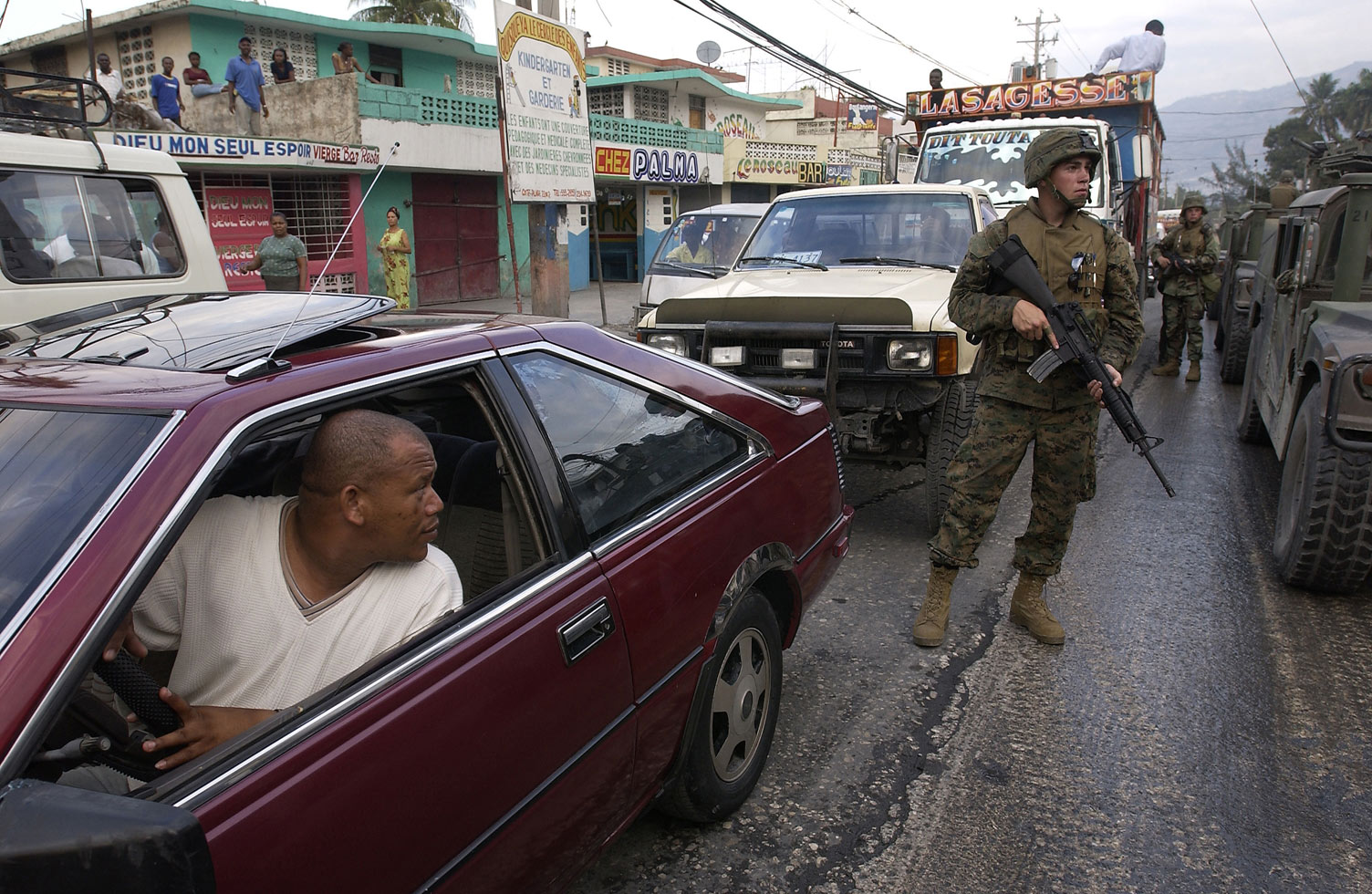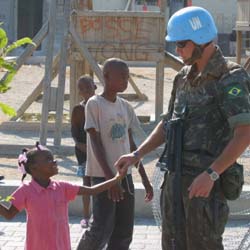|
Cité Soleil Raid Of 2007
The Cité Soleil raid of 2007 began on February 10, 2007, in the Cité Soleil district of Port-au-Prince, capital city of Haiti. It was intended to crack down on a notorious gang leader called "Evans". The raid was part of the United Nations Stabilisation Mission in Haiti. Background The raid started in the early morning of the 9th of February when 700 UN troops accompanied by 34 Armored personnel carriers An armoured personnel carrier (APC) is a broad type of armoured military vehicle designed to transport personnel and equipment in combat zones. Since World War I, APCs have become a very common piece of military equipment around the world. Acc ... assaulted the slums of Cité Soleil, which is controlled by several gangs. When the UN troops entered the area they were ambushed and a battle was started between the troops and heavily armed gang members. The raid ensued until the next day, when fierce resistance was still in place. The raid ended and the gang members surr ... [...More Info...] [...Related Items...] OR: [Wikipedia] [Google] [Baidu] |
United Nations Stabilization Mission In Haiti
The United Nations Stabilisation Mission in Haiti (french: Mission des Nations Unies pour la stabilisation en Haïti), also known as MINUSTAH, an acronym of the French name, was a UN peacekeeping mission in Haiti that was in operation from 2004 to 2017. The mission's military component was led by the Brazilian Army and the force commander was Brazilian. The force was composed of 2,366 military personnel and 2,533 police, supported by international civilian personnel, a local civilian staff and United Nations Volunteers. Following the 2010 Haiti earthquake, the United Nations reported that the headquarters of the mission in Port-au-Prince had collapsed and that the mission's chief, Hédi Annabi of Tunisia, his deputy Luiz Carlos da Costa of Brazil, and the acting police commissioner, RCMP Supt. Doug Coates of Canada, were confirmed dead. On 14 January 2010, UN headquarters dispatched the former head of MINUSTAH and current Assistant Secretary-General for Peacekeeping Operat ... [...More Info...] [...Related Items...] OR: [Wikipedia] [Google] [Baidu] |
Cité Soleil
Cité Soleil ( ht, Site Solèy; English: ) is an extremely impoverished and densely populated commune located in the Port-au-Prince metropolitan area in Haiti. Cité Soleil originally developed as a shanty town and grew to an estimated 200,000 to 400,000 residents, the majority of whom live in extreme poverty. The area is generally regarded as one of the poorest and most dangerous areas of the Western Hemisphere and it is one of the biggest slums in the Northern Hemisphere. The area has virtually no sewers and has a poorly maintained open canal system that serves as its sewage system, few formal businesses but many local commercial activities and enterprises, sporadic but largely unpaid for electricity, a few hospitals, and two government schools, ''Lycee Nationale de Cité Soleil'', and Ecole Nationale de Cité Soleil. For several years until 2007, the area was ruled by a number of gangs, each controlling their own sectors. But government control was reestablished after a series ... [...More Info...] [...Related Items...] OR: [Wikipedia] [Google] [Baidu] |
Haitian National Police
The Haitian National Police (PNH; french: Police Nationale d'Haïti, , National Police of Haiti) is the law enforcement and ''de facto'' police force of Haiti. It was created in 1995 to bring public security under civilian control as mandated in Haiti's constitution. More than 8,500 police officers have completed training. The police force is divided into different divisions to tackle the many problems facing Haiti. Many of these divisions are specialised to address particular chronic crimes that affect the nation, including kidnapping, drugs and gangs. The force also has a Coast Guard and paramilitary units. The United Nations Stabilization Mission in Haiti has implemented a series of plans to increase the size of the police force to 14,000. History Under Jean-Claude Duvalier, the Haitian Police was part of the Haitian Army from 1912 and had 14,000 members divided between the blue-uniformed Port-au-Prince Police and the Rural Security Companies. Since 1987, successive governme ... [...More Info...] [...Related Items...] OR: [Wikipedia] [Google] [Baidu] |
Port-au-Prince
Port-au-Prince ( , ; ht, Pòtoprens ) is the capital and most populous city of Haiti. The city's population was estimated at 987,311 in 2015 with the metropolitan area estimated at a population of 2,618,894. The metropolitan area is defined by the IHSI as including the communes of Port-au-Prince, Delmas, Cite Soleil, Tabarre, Carrefour and Pétion-Ville. The city of Port-au-Prince is on the Gulf of Gonâve: the bay on which the city lies, which acts as a natural harbor, has sustained economic activity since the civilizations of the Taíno. It was first incorporated under French colonial rule in 1749. The city's layout is similar to that of an amphitheater; commercial districts are near the water, while residential neighborhoods are located on the hills above. Its population is difficult to ascertain due to the rapid growth of slums in the hillsides above the city; however, recent estimates place the metropolitan area's population at around 3.7 million, nearly half of the ... [...More Info...] [...Related Items...] OR: [Wikipedia] [Google] [Baidu] |
United Nations Stabilisation Mission In Haiti
) , leader_title = Head , leader_name = Sandra Honoré (Special Representative of the Secretary-General) , status = Replaced by MINUJUSTH , formation = 1 June 2004 , websiteUN Peacekeeping: MINUSTAH , parent_organization = UN , , subsidiaries = , footnotes = The United Nations Stabilisation Mission in Haiti (french: Mission des Nations Unies pour la stabilisation en Haïti), also known as MINUSTAH, an |
Armored Personnel Carriers
An armoured personnel carrier (APC) is a broad type of armoured military vehicle designed to transport personnel and equipment in combat zones. Since World War I, APCs have become a very common piece of military equipment around the world. According to the definition in the Treaty on Conventional Armed Forces in Europe, an APC is "an armoured combat vehicle which is designed and equipped to transport a combat infantry squad and which, as a rule, is armed with an integral or organic weapon of less than 20 millimetres calibre." Compared to infantry fighting vehicles (IFVs), which are also used to carry infantry into battle, APCs have less armament and are not designed to provide direct fire support in battle. Infantry units which travel in APCs are known as mechanized infantry. Some militaries also make a distinction between infantry units which use APCs and infantry units which use IFVs, with the latter being known as armoured infantry in such militaries. History The genesis o ... [...More Info...] [...Related Items...] OR: [Wikipedia] [Google] [Baidu] |
2007 In Haiti
7 (seven) is the natural number following 6 and preceding 8. It is the only prime number preceding a cube. As an early prime number in the series of positive integers, the number seven has greatly symbolic associations in religion, mythology, superstition and philosophy. The seven Classical planets resulted in seven being the number of days in a week. It is often considered lucky in Western culture and is often seen as highly symbolic. Unlike Western culture, in Vietnamese culture, the number seven is sometimes considered unlucky. It is the first natural number whose pronunciation contains more than one syllable. Evolution of the Arabic digit In the beginning, Indians wrote 7 more or less in one stroke as a curve that looks like an uppercase vertically inverted. The western Ghubar Arabs' main contribution was to make the longer line diagonal rather than straight, though they showed some tendencies to making the digit more rectilinear. The eastern Arabs developed the digit f ... [...More Info...] [...Related Items...] OR: [Wikipedia] [Google] [Baidu] |
Human Rights Abuses In Haiti
Humans (''Homo sapiens'') are the most abundant and widespread species of primate, characterized by bipedalism and exceptional cognitive skills due to a large and complex brain. This has enabled the development of advanced tools, culture, and language. Humans are highly social and tend to live in complex social structures composed of many cooperating and competing groups, from families and kinship networks to political states. Social interactions between humans have established a wide variety of values, social norms, and rituals, which bolster human society. Its intelligence and its desire to understand and influence the environment and to explain and manipulate phenomena have motivated humanity's development of science, philosophy, mythology, religion, and other fields of study. Although some scientists equate the term ''humans'' with all members of the genus ''Homo'', in common usage, it generally refers to ''Homo sapiens'', the only extant member. Anatomically modern huma ... [...More Info...] [...Related Items...] OR: [Wikipedia] [Google] [Baidu] |






